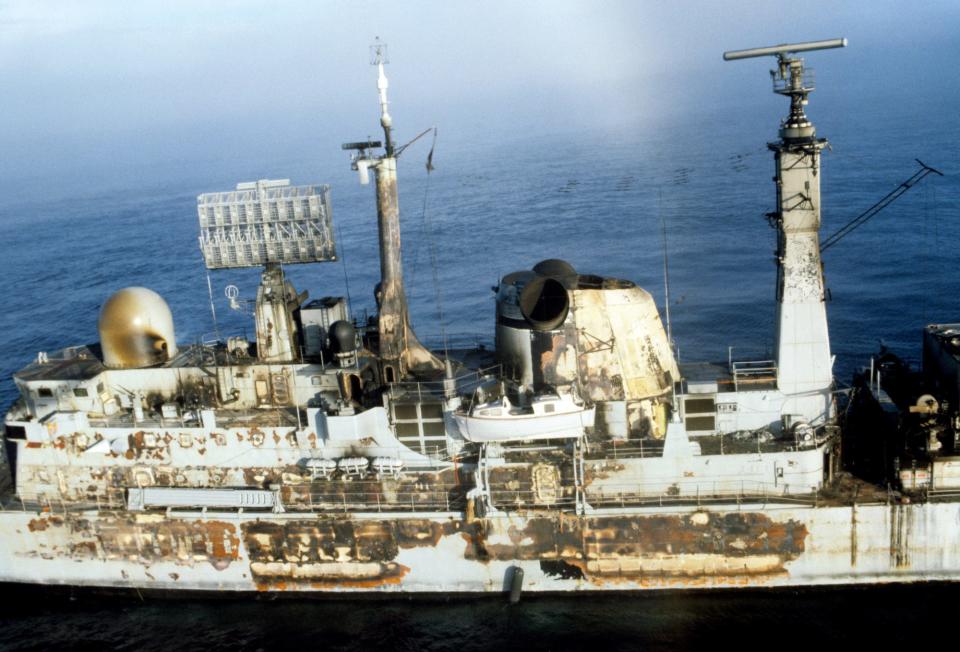The sinking of Russia's Black Sea Fleet flagship highlights deadly lessons learned in another war 40 years ago

Ukraine surprised the world by sinking Russian missile cruiser Moskva in the Black Sea this spring.
The attack showed how modern warships are susceptible to well-planned attacks with modern weapons.
It was a demonstration of vulnerabilities on display in a South Atlantic naval clash 40 years ago.
In late April, Ukraine surprised Russia and the world by sinking Russian guided-missile cruiser Moskva with what one official said were two well-placed anti-ship missiles.
Russia's navy has mostly dominated the waters around Ukraine during the war, so Ukraine sinking the Moskva — the flagship of Russia's Black Sea Fleet — was unexpected and highlighted the potency of anti-ship missiles even against well-defended ships.
The way Moskva was sunk is also a reminder of the deadly lessons learned in another major war 40 years ago.
The Moskva

A Slava-class guided-missile cruiser, the Moskva was designed to take out US aircraft carriers and was outfitted with the weapons to do so.
It could carry 16 P-500 anti-ship missiles, 104 S-300F anti-aircraft missiles, 40 9K33 air-defense missiles, two 130mm cannons, anti-submarine mortars, torpedoes, and six close-in weapon systems. Because of its armament and size — more than 600 feet long and displacing over 11,000 tons — Moskva would difficult to sink.
On the night of April 13, the Ukrainian military launched two Neptune anti-ship missiles that flew about 50 feet above the water on their way to Moskva. As they neared the warship, they dropped to just above the surface to avoid the ship's missile defenses.
The Ukrainians had to aim their Neptunes very well, but after their impact, cascading explosions fueled by Moskva's munitions, as well as what was likely its crew's poor training and leadership, helped doom the Russian ship.

Ukraine's military reportedly used a Bayraktar TB2 drone to track Moskva's movements and to distract its crew and sensors from the incoming missiles. The Moskva's sinking is in many regards a reflection of a new age in naval warfare, as the use of a drone to track and distract a large enemy surface ship, making it more vulnerable to attack, is a first.
Since the Moskva was sunk, Russia's navy has largely lost its freedom of movement along Ukraine's coast. Kyiv says its anti-ship missiles have wreaked havoc on Russian warships, sinking 14 small and large vessels as of June.
Surface combatants are by no means obsolete. Aircraft carriers, destroyers, cruisers, and frigates are still highly useful and can fill many roles, ranging from force projection and deterrence to long-range attack and area defense.
But new weapons on display in Ukraine add to the threats that have long challenged surface ships' ability to survive in modern warfare, as illustrated in the naval clashes of the Falklands War.
ARA General Belgrano and HMS Sheffield

Two incidents during the Falklands War in 1982 highlighted the enduring danger that surface ships faced from air and undersea threats.
On May 2, 1982, after days of hunting, British nuclear-powered submarine HMS Conqueror launched three Mark 8 torpedoes at Argentine light cruiser ARA General Belgrano. Within minutes, the Argentine warship was sinking, taking 323 of its 1,100 crew with it.
Belgrano was only the second surface warship to be sunk by a submarine since World War II, and it showed the danger that subs pose to surface combatants.
Days later, Argentina struck back. On May 4, Argentine jets attacked HMS Sheffield, a Type 42 guided-missile destroyer, launching two AM39 Exocet anti-ship cruise missiles and scoring one hit.
Residual fuel from missile triggered a blaze in the ship, eventually igniting Sheffield's fuel tank and destroying most of the forward part of the vessel. The destroyer sank on May 10, as it was being towed by another British ship. Of the 268 crew, 20 were killed and dozens more injured.

HMS Sheffield was one of four ships that the British would lose to Argentine air attacks. Argentine aircraft struck three Royal Navy vessels with Exocets, sinking each and killing 46 British sailors.
Guided missiles were first used to sink ships during World War II, and the Falklands War showed the enduring danger they posed, even to advanced warships. Following the war, the US Navy tested Exocets against its own defenses, which downed all but one of the dozen missiles fired at US ships, according to John Lehman, the secretary of the Navy at the time.
"The cruise missile is nothing new for naval forces. It's clear the Russians either never learned the lessons, more probably, or forgot them all, because almost every lesson that came out of World War II and subsequent wars was ignored in the Moskva," Lehman told at a think-tank audience in April.
"The worry is that US and Western and NATO navies have forgotten what they should be remembering in training and in equipment and in materiel and in ship design. All of those things are important in naval warfare," Lehman said.
Stavros Atlamazoglou is a defense journalist specializing in special operations, a Hellenic Army veteran (national service with the 575th Marine Battalion and Army HQ), and a Johns Hopkins University graduate.
Read the original article on Business Insider


